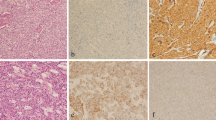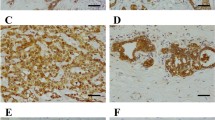Abstract
Purpose
The basal-like phenotype has been found to be an independent poor prognostic factor for breast cancer. The aim of this study was to evaluate the association of WW domain-containing oxidoreductase (WWOX) expression with the basal-like subtype and clinicopathological parameters and to determine the prognostic significance of WWOX expression in patients with breast cancer.
Methods
Immunohistochemical analysis of WWOX expression was performed on 267 breast carcinoma samples, and then the mean value of WWOX expression was correlated to the basal-like status and clinicopathological parameters of the samples. The prognostic value of WWOX in primary breast cancer patients was determined for disease-free survival and overall survival.
Results
Expression of WWOX was negative in 29% of cases, and mean WWOX levels were significantly lower in basal-like breast cancers than in those of the non-basal-like subtype (P = 0.01). WWOX negativity was associated with decreased disease-free survival (DFS) (hazard ratio = 1.83; 95% CI, 1.01 to 3.28), but not with overall survival. Other tumor variables that showed a significant association with patient survival times included node status (hazard ratio = 0.38; 95% CI, 0.17 to 0.85) and breast cancer phenotype (hazard ratio = 0.36; 95% CI, 0.19 to 0.68). Multivariate regression analysis showed that lymph node involvement (hazard ratio = 0.43; 95% CI, 0.19 to 0.97) and basal-like subtype (hazard ratio = 0.33; 95% CI, 0.17 to 0.63) were also significant independent prognostic variables, and WWOX expression was of borderline significance for DFS (hazard ratio = 0.56; 95% CI, 0.31 to 1.03).
Conclusions
Reduced WWOX expression is associated with the basal-like subtype and a poor disease-free survival rate for breast cancer patients. Additional studies are warranted to better understand the role of WWOX expression, to further refine prognosis, and to optimize treatment in patients with basal-like breast cancer.


Similar content being viewed by others
References
Aqeilan RI, Kuroki T, Pekarsky O et al (2004) Loss of WWOX expression in gastric carcinoma. Clin Can Res 10(9):3053–3058
Bednarek AK, Laflin KJ, Daniel RL, Liao Q, Hawkins KA, Aldaz CM (2000) WWOX, a novel domain-containing protein mapping to human chromosome 16q23.3–24.1, a region frequently affected in breast cancer. Cancer Res 60(8):2140–2145
Bednarek AK, Keck-Waggoner CL, Daniel RL et al (2001) WWOX, the FRA16D gene, behaves as a suppressor of tumor growth. Cancer Res 61(22):8068–8073
Cheang MC, Voduc D, Bajdik C et al (2008) Basal-like breast cancer defined by 5 biomarkers has superior prognostic value than triple-negative phenotype. Clin Cancer Res 14(5):1368–1376
Greene FI, Page DI, Fleming ID (2002) AJCC cancer staging manual, 6th edn. Springer, New York
Guler G, Ulner A, Guler N et al (2004) The fragile genes FHIT and WWOX are inactivated coordinately in invasive breast carcinoma. Cancer 100(8):1605–1614
Guler G, Iliopoulos D, Guler N, Himmetoglu C, Hayran M, Huebner K (2007) WWOX and Ap2r expression levels predict tamoxifen response. Clin Cancer Res 13:6115–6121
Haffty BG, Yang Q, Reiss M et al (2006) Locoregional relapse and distant metastasis in conservatively managed triple negative early-stage breast cancer. J Clin Oncol 24(36):5652–5657
Iliopoulos D, Guler G, Han SH-Y et al (2005) Fragile genes as biomarkers: epigenetic control of WWOX and FHIT in lung, breast and bladder cancer. Oncogene 24(9):1625–1633
Iliopoulos D, Fabbri M, Druck T, Qin HR, Han SY, Huebner K (2007) Inhibition of breast cancer cell growth in vitro and in vivo: effect of restoration of WWOX expression. Clin Cancer Res 13(1):268–274
Jimenez RE, Wallis T, Visscher DW (2001) Centrally necrotizing carcinomas of the breast: a distinct histologic subtype with aggressive clinical behavior. Am J Surg Pathol 25(3):331–337
Kreike B, van Kouwenhove M, Horlings H et al (2007) Gene expression profiling and histopathological characterization of triple negative/basal-like breast carcinomas. Breast Cancer Res 9(5):R65
Kuroki T, Trapasso F, Shiraishi T et al (2002) Genetic alterations of the tumor suppressor gene WWOX in esophageal squamous cell carcinoma. Cancer Res 62(8):2258–2260
Kuroki T, Yendamuri S, Trapasso F et al (2004) The tumor suppressor gene WWOX at FRA16D is involved in pancreatic carcinogenesis. Clin Cancer Res 10(7):2459–2465
Le Doussal V, Tubiana-Hulin M, Friedman S, Hacene K, Spyratos F, Brunet M (1989) Prognostic value of histologic grade nuclear components of Scarff-Bloom-Richardson (SBR): an improved score modification based on a multivariate analysis of 1262 invasive ductal breast carcinomas. Cancer 64(9):1914–1921
Livasy CA, Karaca G, Nanda R et al (2006) Phenotype evaluation of the basal-like subtype of invasive breast carcinoma. Mod Pathol 19(2):264–271
Nielsen TO, Hsu FD, Jensen K et al (2004) Immunohistochemical and clinical characterization of the basal-like subtype of invasive breast carcinoma. Clin Cancer Res 10(16):5367–5374
Nunez MI, Rosen DG, Ludes-Meyers JH et al (2005a) WWOX protein expression varies among ovarian carcinoma histotypes and correlates with less favorable outcome. BMC Cancer 5(1):64
Nunez MI, Ludes-Meyers J, Abba MC et al (2005b) Frequent loss of WWOX expression in breast cancer: correlation with estrogen receptor status. Breast Cancer Res Treat 89(2):99–105
Paige AJ, Taylor KJ, Taylor C et al (2001) WWOX: a candidate tumor suppressor gene involved in multiple tumor types. Proc Natl Acad Sci 98(20):11417–11422
Parikh RR, Housman D, Qifeng Y, Toppmeyer D, Wilson LD, Haffty BG (2008a) Prognostic value of triple-negative phenotype at the time of locally recurrent, conservatively treated breast cancer. Int J Radiat Oncol Biol Phys 72(4):1–8
Parikh RR, Yang Q, Higgins SA, Haffty BG (2008b) Outcomes in young women with breast cancer of triple-negative phenotype: the prognostic significance of CK19 expression. Int J Radiat Oncol Biol Phys 70(1):35–42
Park SW, Ludes-Meyers J, Zimonjic DB, Durkin ME, Popescu NC, Aldaz CM (2004) Frequent downregulation and loss of WWOX gene expression in human hepatocellular carcinoma. Br J Cancer 91(4):753–759
Perou CM, Sorlie T, Eisen MB et al (2000) Molecular portraits of human breast tumours. Nature 406(6797):747–752
Purohit A, Newman SP, Reed MJ (2002) The role of cytokines in regulating estrogen synthesis: implications for the etiology of breast cancer. Breast Cancer Res 4(2):65–69
Rakha EA, El-Sayed ME, Green AR, Lee AH, Robertson JF, Ellis IO (2007) Prognostic markers in triple-negative breast cancer. Cancer 109(1):25–32
Rakha EA, Reis-Filho JS, Ellis IO (2008) Basal-like breast cancer: a critical review. J Clin Oncol 26(15):2568–2581
Sorlie T, Tibshirani R, Parker J et al (2003) Repeated observation of breast tumor subtypes in independent gene expression data sets. Proc Natl Acad Sci USA 100(14):8418–8423
Tuck AB, O’Malley FP, Singhal H et al (1997) Osteopontin and p53 expression are associated with tumor progression in a case of synchronous, bilateral, invasive mammary carcinomas. Arch Pathol Lab Med 121(6):578–584
Turner BC, Gumbs AA, Carter D, Glazer PM, Haffty BG (2004) Cyclin D1 expression and early breast cancer recurrence following lumpectomy and radiation. Int J Radiat Oncol Biol Phys 47(5):1169–1176
Wang X, Chao L, Ma G et al (2008) Increased expression of osteopontin in patients with triple-negative breast cancer. Eur J Clin Invest 38(6):438–446
Yendamuri S, Kuroki T, Trapasso F et al (2003) WW Domain containing oxidoreductase gene expression is altered in non-small cell lung cancer. Cancer Res 63(4):878–881
Acknowledgments
This work supported, in whole or in part, by grants from Shandong Province Natural Science Foundation (No. Y2006C30), Shandong Health and Medicine Founds, China Postdoctoral Foundation (No.20090461225, 20090461226), Doctor Funds of Shandong Province (No. BS2009SW031), and Science and Technology Development Plan of Jinan, China (No. 061033-2).
Conflict of interest statement
None.
Author information
Authors and Affiliations
Corresponding author
Additional information
X. Wang and L. Chao contributed equally to this work.
Rights and permissions
About this article
Cite this article
Wang, X., Chao, L., Ma, G. et al. The prognostic significance of WWOX expression in patients with breast cancer and its association with the basal-like phenotype. J Cancer Res Clin Oncol 137, 271–278 (2011). https://doi.org/10.1007/s00432-010-0880-1
Received:
Accepted:
Published:
Issue Date:
DOI: https://doi.org/10.1007/s00432-010-0880-1




